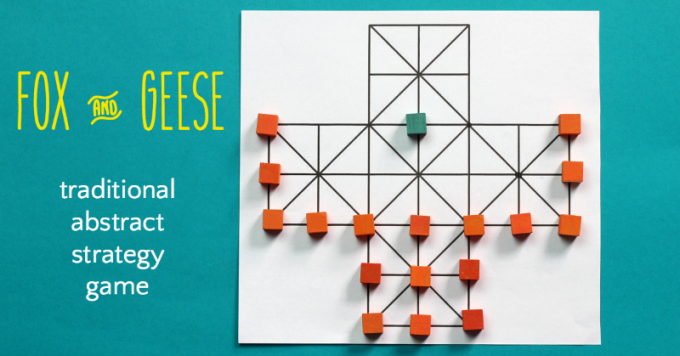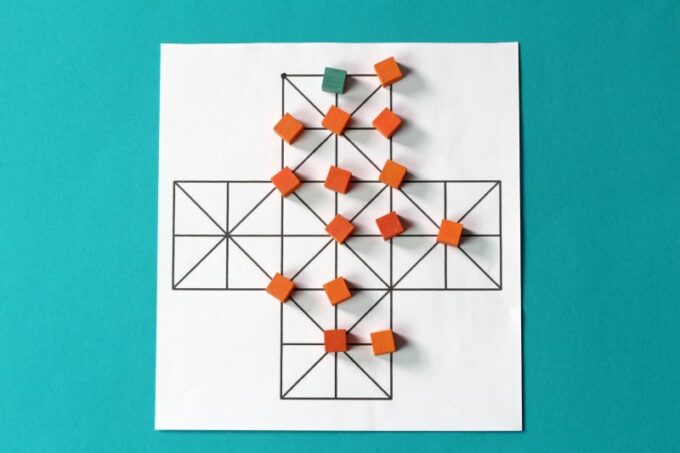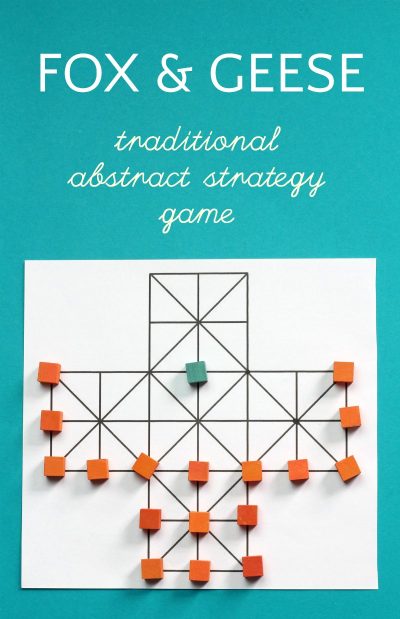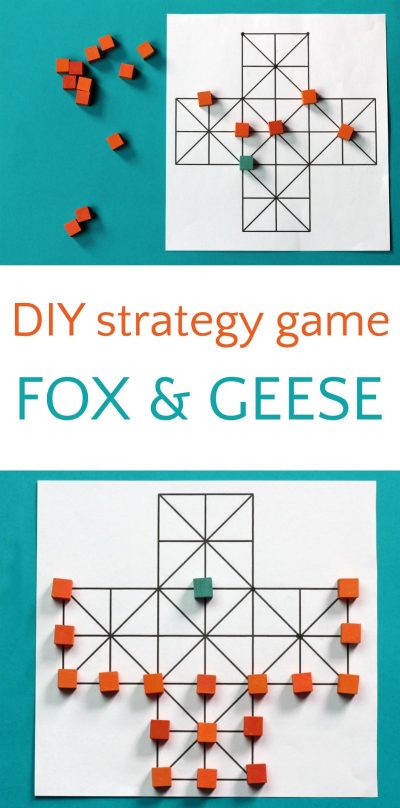Did you know that playing abstract strategy games like Fox and Geese help build skills necessary for success in STEM subjects? That's right. You can keep your kids busy, have fun and feel justifiably smug knowing you are helping them prepare for future academic success. Win-win-win-win!
My children and I have been having a grand time playing this Fox and Geese game, which sounds like it would be a variation on a game of tag, but is actually a traditional abstract strategy board game from Northern Europe. Kids' legs get exercise during tag, but remind them that the brain is a muscle and it needs exercise, too! Fox and Geese exercises the following skills in kids' brains:
- Observation
- Concentration
- Memory
- Planning ahead and analyzing
- Logic and reasoning
- Geometric understanding (especially if you draw your own game board)
How to Play Fox and Geese
What you need:
- 2 enthusiastic players
- A Fox and Geese game board. Download and print ours here, or make your own for some geometry drawing practice. (Use the above photo as a guide.)
- 18 tokens: 17 in one color, 1 in a different color. You can raid your game closet for tokens, or use coins or other small objects.
Fox and Geese rules:
Objective: The fox's objective is to remove as many geese as possible from the board, making it impossible for the geese to trap him. Alternatively, if he moves past the geese to the opposite side of the board, he wins. The geese win if they succeed in trapping the fox so he cannot move.
Place the tokens in the opening positions as shown in top photo.
The fox moves first.
The fox can move along the lines in any direction.
If there is an empty space along the line immediately after the goose, the fox can jump over the goose. Consecutive jumps are allowed. Jumped geese are captured and removed from the board.
Geese may move forward, sideways, diagonally, but not backwards.
Geese may not jump.
Here is an example of a trapped fox:
Variations of Fox and Geese:
As will all traditional games, you can find many recorded versions of the rules. Challenge your kids to try the following variations and ask themselves, "Which rules give the advantage to the fox and which rules give the advantage to the geese?"
- Play with only 13 geese. (This was the original version of the game, but more geese were added at a later date to level the playing field.)
- The geese can only move diagonally and forwards, not sideways or backwards
- The geese can move in any direction (including backwards).
- The fox must jump a goose if he has the opportunity. If he does not, a captured goose is put back into play, if possible.
- The geese move first.
- The fox can begin from any starting point.
- Neither the fox, nor the geese can move diagonally. It might help to draw a new board without the diagonal lines.
In the below image, if the fox starts at the top and the geese from below, the fox wins because no geese can move backwards to trap him.
See it in action!
History of Fox and Geese
Fox and Geese is a traditional battle game with origins in Northern Europe. It is a variation on Halatafl, a Norse Viking board game, mentioned in early Icelandic saga literature. Versions were played throughout European countries and were common up through the 19th century. A survey of traditional games around the world offer several examples of games in which opponents have an uneven number of tokens. (Len Choa from Thailand is one such example.)
More abstract strategy games to make your children smart and sassy:
- Dara: a three in a row game from Nigeria
- Nine Holes: a three in a row game from England
- Five Field Kono: a game from Korea
- Pong Hau K'i: a simple board game from China
- Watermelon chess, a battle game from China
These kinds of games are fantastic for STEAM (Science, Tech, Engineering, Art, and Math) learning which is why I contributed another game, "Hare and Hounds" to the STEAM Kids book. Learn more about the STEAM Kids book - one whole year of splendid STEAM projects for kids!
This post is part of the 28 days of STEAM!










Lisa says
Hi there,
We have been enjoying the Fox & Geese game the last few days but after endless round she of the the fox trouncing the geese we are beginning to suspect that we are doing something wrong. Do the geese ever win?
Erica says
Hi Lisa, I am glad you said this because this was my experience and I thought I was doing something wrong, too, because all the information I read about the game said that the geese have the advantage if they play a perfect game. That just seemed wrong to me. However, I will say, that my 12 yr old beat me as the geese twice so I figured that perhaps this was due to my lack of patience and analytical strategy which he has 100x more of than me! So after reading your comment I took a look again at some of the variations that are out there. (It's an old game which means it has not always been played the same way.) I'm going to add these to the list above of rule changes: 1. Don't use the diagonal lines. (This is the most intriguing to me! A few versions of the board have only straight lines.) 2. Let the geese move backward. I haven't actually seen this, but it might level the playing field. Let me know if you decide to give the game another go and if either of these ideas helped.
Jennie says
Where do you get your little game pieces?
Erica says
Hi Jennie, They are little wooden cubes that I got at a craft store and painted. Similar to these: http://amzn.to/2l0pwXO I hope that helps!
CJ Phaedrus says
You can by a square or round dowel at hardware box stores made of balsa wood which can be cut to size and painted to taste.
Paige says
We used a die for the fox and dry black beans for the geese, popcorn kernels could work too.
WH says
Looking at the instructions is very confusing. In one spot you say the Geese can ONLY move one way, then the next line you say the opposite. Then at the very end you say NO ONE can go diagonal. Please update the rules when it comes to the movements.
The geese can only move diagonally and forwards, not sideways or backwards *********
The geese can move in any direction (including backwards). *****
So which is it..can they or can they not go backwards???
The fox must jump a goose if he has the opportunity. If he does not, a captured goose is put back into play, if possible.
The geese move first.
The fox can begin from any starting point.
Neither the fox, nor the geese can move diagonally. It might help to draw a new board without the diagonal lines.
Earlier you state the geese can go ANY DIRECTION and here you say no one can go diagonally
Erica says
You are confusing the game instructions with my suggested variations.
Bonus Dad says
Assuming that you are using the game instructions as presented through several different sources, what do you do when the geese run out of places to go?
Jeanna says
My Mamaw taught me to play this game when I was small. She drew the board on a piece of paper and used buttons from her sewing kit for the geese and fox. Think of it kind of like checkers in the way that the geese can only move forward and the fox (like a kinged checker) can move both ways. The fox is the only one that can jump over and take geese off the board. The geese have first move and number as their advantage. The fox has jumping and moving in both directions as his.
NatHK says
I've been playing these strategy games with my class and they love them! There's a lot of thinking going on and we're all highly engaged. We particularly love the music in the Fox and Geese video. Can I ask where this is from?